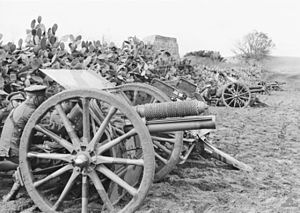- Ordnance QF 13 pounder
-
Ordnance QF 13 pounder 
Battery and crews of Honourable Artillery Company (HAC) near Belah, Palestine, March 1918Type Light field gun Place of origin  United Kingdom
United KingdomService history In service 1904 - present (UK) Used by British Empire Wars World War I, Easter Rising, World War II Production history Number built 416[1] Variants Mk I, Mk II Specifications Weight Barrel & breech
685 lb (311 kg);
Total 2,236 lb (1,014 kg)[2]Barrel length Bore 5 ft 8 in (1.73 m);
Total 6 ft (1.8 m)[2]Crew 9[2] Shell QF fixed round 12.5 lb (5.7 kg) Shrapnel, later HE Calibre 3-inch (76.2 mm) Recoil Hydro-spring, constant, 41 in (1.0 m)[2] Carriage Wheeled, pole trail Elevation -5°to +16°[2] Traverse 4° L & R[2] Muzzle velocity 1,675 ft/s (511 m/s)[2] Maximum range 5,900 yd (5,400 m)[1] The Ordnance QF 13-pounder quick-firing field gun was the standard equipment of the British Royal Horse Artillery at the outbreak of World War I.
Contents
History
It was developed as a response to combat experience gained in the Boer War and entered service in 1904, replacing the Ehrhard QF 15 pounder and BL 12 pounder 6 cwt. It was intended as a rapid-firing and highly-mobile yet reasonably powerful field gun for Royal Horse Artillery batteries attached to Cavalry divisions, which were expected to be engaged in mobile open warfare.
The original Mk I barrel was wire wound.[2] Later Mk II barrels had a tapered inner A tube [1] which was pressed into the outer tube.
The first British artillery round on the Western Front in World War I was fired by No. 4 gun of E Battery Royal Horse Artillery on 22 August 1914, northeast of Harmignies in Belgium.[3]
It saw action most famously at the Battle of Le Cateau in August 1914 as the British Expeditionary Force retreated from Mons.
It was used to great effect by "L" Bty, Royal Horse Artillery in its famous defensive action on September 1 1914 at Néry, France, for which 3 Victoria Crosses were awarded. The medals and No. 6 gun involved in this action are exhibited at the Imperial War Museum, London.
From late 1914, when the Western Front settled into trench warfare, the 13-pounder was found to be too light to be truly effective against prepared defensive positions. As a result, it was increasingly supplanted by the 18-pounder.
As the war progressed, however, the increasing air activity created a requirement for a medium anti-aircraft gun. Redundant 13-pounders were slightly modified to become "Ordnance QF 13 pdr Mk III" and mounted on high-angle mounts to produce what became known as the 13 pounder 6 cwt anti-aircraft gun.
In 1940, some 13-pounders were brought out of store for use as emergency anti-tank guns, mounted in pill boxes[4], for the home defence of Britain against possible German invasion.
For combat purposes the gun is long obsolete, yet it remains in service with the King's Troop, Royal Horse Artillery for ceremonial and salute purposes.[1]
Ammunition


Mk II Shrapnel round No. 80 T. & P. (Time and Percussion) Fuze Shrapnel shell on display at the Australian War Memorial, Canberra
234 balls, 41/lb[2]Sectioned high explosive round, on display at Imperial War Museum London
Shell contained 9oz 4dr (262 gm) Amatol explosive (white area). Cartridge held 1 lb 3.9 oz (536 gm) Cordite propellant (simulated with bundle of cut string)[2]See also
- Edward Kinder Bradbury
- George Thomas Dorrell
- David Nelson
- List of field guns
- QF 13 pounder 6 cwt AA gun: WWI improvised anti-aircraft version
- QF 13 pounder 9 cwt: later WWI anti-aircraft version (18 pounder gun modified to fire 13 pounder ammunition)
Surviving examples
- With the King's Troop, Royal Horse Artillery, London
- The Néry Gun at Imperial War Museum Victoria Cross and George Cross Gallery, London
- Ammunition wagon of L Battery, at Imperial War Museum, Duxford, England
- No. 4 gun of E Battery RHA, which fired the first British artillery round of WWI on the Western Front. At Imperial War Museum North, Manchester UK
- Canadian War Museum, Ottawa
- Fort Seclin - 1914/1918 Museum (Between Ypres and Vimy - Near Fromelles)
- Musee des Abris, Albert, France. (Mk. 2)
- There are 6 examples in South Africa : Pictures available on request, please contact via the 1914-1918 forum noted below :
- 1 being restored, see http://1914-1918.invisionzone.com/forums/index.php?showtopic=122427&view=getnewpost,
- 1 at THA HQ in Johannesburg,
- 2 with the NFA in Durban,
- 2 at our National Memorial in Potchefstroom.
Notes and references
- ^ a b c d Clarke 2004
- ^ a b c d e f g h i j Hogg & Thurston 1972, page 58
- ^ Farndale 1986, page 10
- ^ Cruickshank 2001
Bibliography
- Dale Clarke, British Artillery 1914-1919. Field Army Artillery. Osprey Publishing, Oxford UK, 2004
- Cruickshank, Dan, Invasion - Defending Britain from Attack. Boxtree, 2001 ISBN 0752220292
- General Sir Martin Farndale, History of the Royal Regiment of Artillery Western Front 1914-18. Published by Royal Artillery Institution, 1986. ISBN 1 870114 00 0
- I.V. Hogg & L.F. Thurston, British Artillery Weapons & Ammunition 1914-1918. published by Ian Allan, London, 1972.
External links
- The Néry Gun at Imperial War Museum Victoria Cross and George Cross Gallery
- Per Finsted, The Affair at Néry, 1 September 1914. With map, illustrations and photographs of gun and ammunition wagon
- Chris Baker, The British artillery weapons of 1914-1918
Categories:- Field guns
- World War I guns
- World War I artillery of the United Kingdom
- 76 mm artillery
Wikimedia Foundation. 2010.




